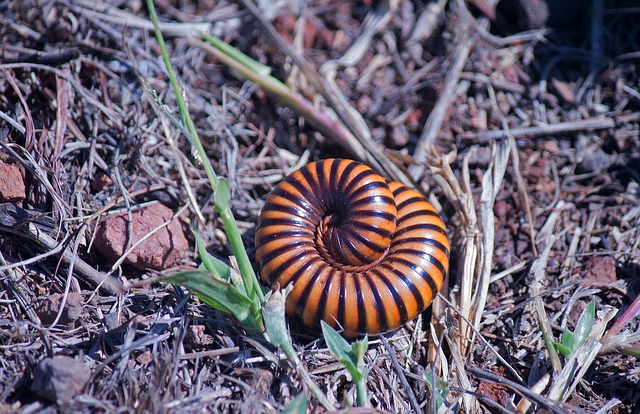Millipedes in homes are managed through understanding their behavior, focusing on damp, dark spaces and addressing attractants like moisture. Eco-conscious methods gain popularity, with techniques like pheromone traps and Integrated Pest Management (IPM) strategies that minimize environmental impact. Homeowners can aid in non-toxic extermination by maintaining dryness, sealing entry points, using natural repellents, and introducing predators. Long-term prevention involves proper sanitation, drainage, and reducing organic debris to deter millipedes and support biodiversity.
In many residential settings, millipedes have become a persistent pest. However, there’s a growing demand for humane and eco-conscious solutions for their management. This comprehensive guide explores effective strategies for dealing with millipedes in homes, focusing on non-toxic methods and sustainable practices. From understanding these creatures’ behavior to implementing eco-friendly monitoring techniques, we provide practical steps for achieving successful residential millipede extermination without causing harm to the environment or beneficial insects.
Understanding Millipedes: Behavior and Habitat in Residential Settings
Millipedes are fascinating creatures, despite their unappealing appearance. In residential settings, they primarily seek damp, dark spaces, often moving through cracks and crevices to find suitable habitats. Understanding their behavior is crucial for effective millipede management in homes. These invertebrates prefer environments with high humidity, making them more active during night hours when moisture levels are higher. They are not aggressive but can become a nuisance when their populations grow, as they leave behind a trail of sticky secretions that can attract other pests and cause odors.
When it comes to residential millipede extermination, it’s essential to address the underlying factors that attract them. Maintaining proper ventilation, fixing leaks, and reducing moisture levels in areas like basements, crawl spaces, and bathrooms can significantly deter these creatures. Regular cleaning and sealing entry points also play a vital role in humane management methods. Instead of harmful chemicals, eco-conscious approaches focus on natural repellents, improved sanitation, and strategic exclusions to ensure a millipede-free home without causing harm to the environment or non-target species.
Eco-Friendly Identification and Monitoring Techniques
In the realm of residential millipede extermination, eco-friendly identification and monitoring techniques are transforming the way we manage these tiny creatures. Instead of relying on harsh chemicals, professionals now employ non-toxic methods to both track and control populations. One such technique involves using pheromone traps, which attract millipedes without causing them harm. These traps offer a humane alternative by capturing and studying the insects without damaging their natural behavior or ecosystem.
Additionally, integrated pest management (IPM) strategies emphasize prevention and the use of least-toxic methods first. This approach includes regular inspections to identify entry points, proper sanitation practices, and the introduction of natural predators like spiders and centipedes. By combining these eco-conscious techniques with strategic monitoring, residential millipede extermination can become a sustainable process that minimizes environmental impact while effectively managing infestations.
Non-Toxic Management Strategies for Effective Residential Millipede Extermination
When it comes to non-toxic residential millipede extermination, there are several effective strategies that homeowners can employ without resorting to harmful chemicals. One key approach is maintaining a clean and dry environment, as millipedes are attracted to moisture. Regularly sweeping floors, wiping down surfaces, and ensuring proper drainage can significantly reduce their presence. Additionally, sealing entry points like cracks and gaps in walls or foundations helps prevent them from entering homes in the first place.
Using natural repellents is another humane method. Peppermint oil, cinnamon, and cloves have been shown to deter millipedes due to their strong scents. Dispensing these essential oils in affected areas or placing them near entry points can act as a non-toxic barrier. Moreover, introducing natural predators like spiders and centipedes (while ensuring they are not a nuisance to humans) can help regulate millipede populations without causing harm to the environment or other beneficial insects.
Long-Term Prevention and Control Measures: A Sustainable Approach
In the long term, effective residential millipede extermination goes beyond quick fixes and focuses on sustainable prevention and control measures. This approach involves addressing the environmental conditions that favor millipedes, such as excessive moisture and organic debris. Homeowners can play a significant role by maintaining proper sanitation, regularly removing leaf piles, and ensuring drainage systems are functioning optimally. These proactive steps not only reduce millipede habitats but also foster an overall healthier and more balanced ecosystem within residential areas.
Additionally, integrating eco-conscious practices into residential millipede management strategies is essential. This includes the careful selection of non-toxic, environmentally friendly repellents or natural predators that can help control millipede populations. By adopting these sustainable methods, residents contribute to a safer and greener living environment while minimizing potential harm to beneficial insects and the overall biodiversity surrounding their homes.
In conclusion, managing millipedes in residential settings requires a balanced approach that combines understanding their behavior, eco-friendly methods, non-toxic strategies, and long-term prevention. By adopting these humane and sustainable practices, homeowners can effectively control millipede populations without causing harm to the environment or other beneficial insects. When it comes to residential millipede extermination, less toxic solutions prove more effective and environmentally responsible in the long run.
